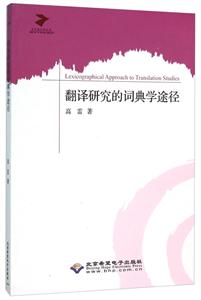翻译研究的词典学途径 版权信息
- ISBN:9787830022792
- 条形码:9787830022792 ; 978-7-83002-279-2
- 装帧:暂无
- 册数:暂无
- 重量:暂无
- 所属分类:>
翻译研究的词典学途径 本书特色
本书是通过词典学途径来研究翻译的专著。作者结合翻译学和词典学的特征、内容和方法系统探讨了翻译学词典的内容来源和展现形式。本书还探讨了翻译学词典研究的理论框架,以及翻译学词典研究对整个翻译学学科发展的功能和意义。同时,作者试图通过翻译学和词典学的跨学科综合来探讨翻译研究中的描写问题、规范问题和系统问题。总之,本书丰富了翻译学研究的途径,证明了翻译学词典研究的学术价值
翻译研究的词典学途径 内容简介
本书是通过词典学途径研究翻译的专著。作者结合翻译学和词典的特征、内容和方法, 系统探讨了翻译学词典的内容来源和展现形式。本书还探讨了翻译学词典研究的理论框架, 以及翻译学词典研究对整个翻译学学科发展的功能和意义。
翻译研究的词典学途径 目录
目录 contents 前言 chapter 1 introduction / 1 1.1 literature review / 1 1.2 research object / 10 1.3 research objective / 12 1.4 research methodology / 13 1.4.1 ontological method / 13 1.4.2 lexicographical method / 14 1.5 significance of the research / 14 1.5.1 translation studies / 14 1.5.2 compilation of translatological dictionaries / 16 1.5.3 lexicographical study of translation / 16 1.6 structure of the research / 17 1.7 originality of the research / 18 1.7.1 probe into the sources of translatological dictionaries / 18 1.7.2 probe into the functions of translatological dictionaries / 19 chapter 2 lexicographical source of translatological dictionaries / 20 2.1 development of lexicography / 20 2.2 characteristics of lexicography / 29 2.2.1 multidiscipline integration / 29 2.2.2 open perspective / 31 2.2.3 pragmatic tendency / 35 2.3 summary / 38 chapter 3 translatological source of translatological dictionaries / 40 3.1 multivariate paradigms of translation studies / 40 3.1.1 paradigm of creativity / 41 3.1.2 paradigm of equivalence / 46 3.1.3 post-structuralist translation theories / 50 3.2 systematicness of translation studies / 55 3.3 openness of translation studies / 60 3.4 summary / 62 chapter 4 constituents of translatological dictionaries / 64 4.1 name and nature of translatological dictionaries / 64 4.2 materials of translatological dictionaries / 67 4.2.1 translatological concepts / 68 4.2.2 translatological terms / 70 4.2.3 translatological proper nouns / 77 4.3 forms of translatological dictionaries / 80 4.3.1 macrostructure / 81 4.3.2 microstructure / 83 4.3.3 physical features / 90 4.4 production of translatological dictionaries / 91 4.4.1 noumenon / 92 4.4.2 phenomenon / 95 4.4.3 unification between noumenon and phenomenon / 97 4.5 purpose of translatological dictionaries / 98 4.6 summary / 101 chapter 5 theories of translatological dictionaries / 102 5.1 compilers / 102 5.1.1 perception / 103 5.1.2 understanding / 104 5.1.3 rationality / 106 5.1.4 professionalism / 108 5.2 inner system of translatological dictionaries / 110 5.2.1 nature of translatological dictionaries / 110 5.2.2 typology of translatological dictionaries / 112 5.2.3 compilation principles of translatological dictionaries / 116 5.2.4 structure of translatological dictionaries / 121 5.2.5 criticism of translatological dictionaries / 123 5.2.6 functions of translatological dictionaries / 125 5.2.7 history of translatological dictionaries / 128 5.3 users / 129 5.3.1 users' consciousness / 129 5.3.2 users' cognitive competence / 131 5.3.3 users' communication / 134 5.4 social background / 137 5.4.1 publication of translatological dictionaries / 137 5.4.2 science and technology / 139 5.4.3 ideology / 142 5.5 summary / 144 chapter 6 discipline functions of std / 146 6.1 study of translatological dictionaries as a sub-discipline / 146 6.1.1 inner impetus / 147 6.1.2 discipline environment / 148 6.1.3 discipline index system / 151 6.2 lexicographical approach to translation studies / 160 6.3 summary / 165 chapter 7 conclusion / 167 7.1 main findings / 167 7.1.1 std as an interdisciplinary research / 167 7.1.2 contributions / 171 7.1.3 ideas of discipline ecology / 176 7.2 limitations of the research / 177 7.2.1 limitation in empirical study / 177 7.2.2 limitation in case study / 178 7.2.3 limitation in research literature / 178 7.3 future study / 179 7.3.1 compilation of more translatological dictionaries / 179 7.3.2 attaching importance to translatological dictionaries and their study / 180 7.3.3 making out criticism specification of the translatological dictionary / 182 bibliography / 187 后记
展开全部
翻译研究的词典学途径 节选
《翻译研究的词典学途径》: A forerunner of the western translation theories, Cicero thought that translation was a kind of artistic creation, which emphasized the effect of a translation.Cicero himself translated many sages' masterpieces in the ancient Greece, such as Homer's Odyssey and Plato's works.In terms of Cicero's artistic viewpoint on translation,Shen Yuping (申雨平) wrote, Cicero aiso proposed that translation was a kind of literary creation, which should accord with the practice of the target language so as to move the prospective readers.Therefore, we should turn to paraphrase.Metaphrase meant that we lacked skills of translation.(Shen Yuping 2002: 156) From the statement above, we can understand that in Cicero's opinion.translation means creation.This is a kind of ontological understanding of translation.His proposition of paraphrase in translation shows that translation methods accord with ontological understandings of translation.Horace, a famous poet and statesman in the ancient Rome, also proposed that translation should be free instead of rigid imitation of the source language.His proposition is closely related to his temperament as a poet.Generally speaking, most of the arts should be a kind of creative activitv rather than a passive one. ……
翻译研究的词典学途径 作者简介
高雷,淮阴师范学院外国语学院副教授,博士,硕士生导师,学术方向为翻译学,第六届江苏翻译协会理事。2010年毕业于山东大学外国语学院,获得英语语言文学博士学位。2012年在英国曼彻斯特大学翻译与跨文化研究中心访学。已发表学术论文二十篇,译著3部,编著1部。主持省部级等科研项目4项
















